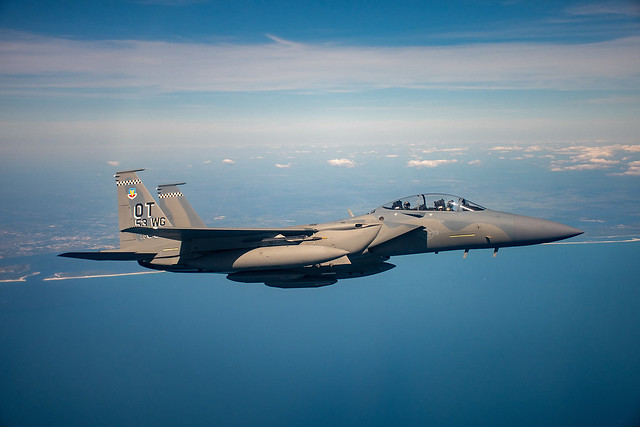
Last week, speaking at the Singapore Air Show, Boeing’s F-15EX program manager said the new version of the Eagle is capable of Mach 3 in a clean configuration. I questioned that claim, and did so publicly on social media.
I had plenty of reason, backed by personal experience, to scoff at the Mach 3 claim. Keep in mind the older F-15s I flew and the new F-15EX share the same airframe, that apart from improved engines and avionics they’re the same aircraft. The F-15 was always the fastest fighter in our inventory, with a potential top speed of Mach 2.5, and I personally managed to get 2.21 out of a new C model on a functional check flight (using up all but the bare minimum of fuel required to return to base doing so). Some Eagle drivers have gone faster, but I’ll bet not by much.
Mach 3! That’s SR-71 Blackbird territory, for goodness’ sake. There’s no way an Eagle, even the new EX model with more thrust from better engines, can go anywhere near that. The difference may look like only a couple of decimal points on paper, but there’s a huge gap between 2.5 and 3 times the speed of sound.
Over the weekend Boeing retracted the claim:”Mach 2.497 is what we can get out of the Eagle jet and that’s close to [Mach] 2.5, but it’s not close to Mach 3.”
An aviation journalist saw my comments on Twitter and DM’d me for additional information, including the lowdown on a cockpit switch I never realized is a topic of great interest to journalists who report on fighter aircraft and the F-15 Eagle in particular, the apparently-infamous Vmax switch.
Yes, there’s a max velocity switch in the Eagle’s cockpit. We were always told never to use it, as it will shorten the life of the engines while giving only a small boost in top speed. The Vmax switch has a cover over it and it’s safety-wired closed. I never saw a switch with the safety wire broken. I never touched it myself, and never heard of any Eagle driver who had. Here’s the relevant paragraph from the F-15 Dash-1 flight manual:
What I want to say, though, is that the Eagle’s potential top speed, while nice (and quite impressive), is nearly useless … never to my knowledge used in combat, even by the Israelis. Useless because a clean F-15 is an unarmed F-15 and can’t fight anybody: an Eagle carrying missiles might be able to achieve Mach 1.5, but that’s about it. Useless because the Eagle doesn’t carry enough fuel to attain even that speed for more than a few seconds. Useless because in the kind of air-to-air shooting scenario modern jet fighters engage in, speeds above Mach 1.5 aren’t necessary. You might choose, if you have the fuel, to enter a fight at or just over the Mach. You might bug out of that fight supersonic. But you won’t do it more than once or twice because you don’t have the gas to sustain it, and you’ll rarely exceed Mach 1.2 to 1.5 when you do.
And then there’s this: in the early 1980s the Air Force detuned the F-15 Eagle’s engines to extend the time between replacements, and at the same time removed the turkey feathers from the afterburner nozzles at the rear of the airplane, increasing drag. Both actions reduced top speed by some undefined amount. Anyone who thinks the F-15EX will escape the same fate is smoking something.
These are some of the thoughts I shared with that aviation journalist, Thomas Newdick of The War Zone, so you may see some of it in print and attributed to me … if you follow that sort of thing. I can only hope he doesn’t find my musings on single- versus two-seat fighters, because I don’t think I can take that kind of heat.
Update (same day): Well, that was fast! Quick turnaround by Thomas Newdick at The War Zone, with testimony from other Eagle and Strike Eagle pilots.

This is from Mike, a friend and former F-15 squadronmate, who chatted with me by DM last night. I asked permission to append his story to my post and he said go for it!
Explanations:
Very good explanation of VMAX! I was a weapons loader from 1991-2003 and then went to avionics until I retired in 2018. When I went to avionics I loved reading the -1. It was very very helpful for troubleshooting pilot write ups (especially flight control issues), but as a fan of the F-15, reading the -1 was a great insight into the jet and what you guys were fooling with in the air. Always wanted to be an F-15 pilot but alas my eyes were not good enough and no waivers were being granted in 1991.